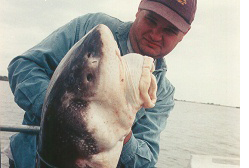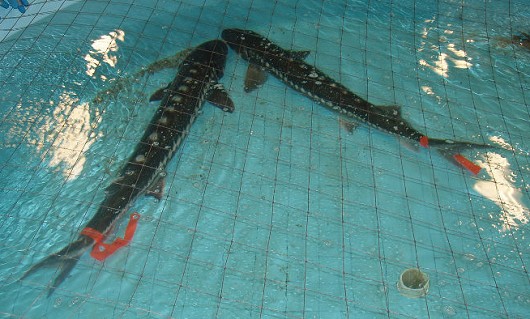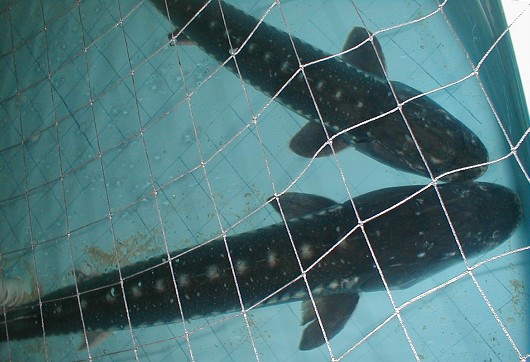White Sturgeon
-
Scientific NameAcipenser transmontanus
-
NativeNative Species
-
Identification
 White sturgeon. Photo courtesy of Professor Peter B. Moyle.
White sturgeon. Photo courtesy of Professor Peter B. Moyle. White sturgeon, mouth. Caught in April 1997 in the Sacramento River (at river mile 14, the tip of Grand Island). Photo courtesy of John Hileman, California Department of Fish and Game.
White sturgeon, mouth. Caught in April 1997 in the Sacramento River (at river mile 14, the tip of Grand Island). Photo courtesy of John Hileman, California Department of Fish and Game. White sturgeon, in tank at UC Davis. Photo courtesy of Dennis Cocherell, UC Davis. Note: fish have orange flagging tape tied to their tails for identification purposes.
White sturgeon, in tank at UC Davis. Photo courtesy of Dennis Cocherell, UC Davis. Note: fish have orange flagging tape tied to their tails for identification purposes. White sturgeon, heads, in tank at UC Davis. Photo courtesy of Dennis Cocherell, UC Davis.
White sturgeon, heads, in tank at UC Davis. Photo courtesy of Dennis Cocherell, UC Davis.- Large fish, recent CA maximum 2.8 m TL (210 kg), rarely longer than 2 m TL
- Historically: may have reached 6 m FL (820kg)
- Heterocercal tail, upper lobe longer
- Ventral mouth, protruding vacuum lips
- Blunt snout, 4 barbels: closer to tip of snout than to mouth
- Gray brown dorsal surface, white underside, gray fins, black viscera
- Rows (5) of bony plates called scutes instead of scales, plate numbers:
- Dorsal row: 11-14 scutes
- Lateral rows (2): 38-48 scutes
- Ventral rows (2): 9-12 scutes
- Large scutes absent behind anal and dorsal fins (remnants may be present)
- Fin rays/spines: dorsal 44-48 rays/1spine, anal 28-31 rays
-
Life History
White sturgeon are anadromous fish that spend most of their lives within an estuary, usually returning to freshwater only to spawn. White sturgeon have been found in some cases to travel hundreds of kilometers to other estuaries and river systems. When sturgeon larvae hatch in a stream they begin swimming around in a vertical position as they are suspended by a yolk sac, making them more susceptible to be carried down to the estuary in the current. After they consume the sac they begin swimming freely and feeding through their mouth. In general the distribution of sturgeon in an estuary is age dependent and a function of salinity tolerance. The younger fish are found on the upstream or freshwater end of an estuary whereas the older fish are found on the ocean side. Once white sturgeon have adapted to the changes in salinity they may move around a bay or estuary to find an optimal type of brackish water. They grow quickly in their first year, up to 30 cm FL in the San Francisco Bay estuary, and the growth rate generally decreases with age. The diet of young sturgeon consists primarily of different types of crustaceans, though they begin to increase the diversity with age. Most food is taken from the bottom of the estuary where the sturgeon may pick up clams, crabs, and shrimp. Larger sturgeon begin to feed on other fish such as anchovies, starry flounder, smelt and striped bass. The opportunism of the white sturgeon can be seen in their documented consumption of crayfish, trout, frogs, salmon, crayfish and even one domestic cat. Male sturgeon reach sexual maturity before the females, though time of onset of maturity for both varies with photoperiod and temperature. Typically males are at least 10-12 years old and have a fork length of 75-105 cm. Females mature when they are 12-16 years old and have a fork length of 95-135 cm. White sturgeon don’t necessarily breed annually and only a small percentage of the adult population spawn in a given season. Males may spawn every 1-2 years and females every 2-4 years. The sturgeon begin migrating in streams during winter, with large peak flows triggering the spawning between February and early June. The optimal water temperature for spawning falls in the range of 8-19°C. Fish biologists believe the white sturgeon pick deep swiftwater areas to spawn such as riffles or pools with rock and gravel substrate. Female sturgeon produce many eggs, with the Sacramento white sturgeon producing an average of 5,648 eggs per kilogram of body weight. Male sturgeon fertilize the eggs, giving them a tacky property that allows the eggs to stick to the substrate till the larvae emerge 4-12 days later. White sturgeons have a long life span that may have exceeded 100 years historically.
-
Links to Other ResearchN / A
-
Watershed
-
Coyote Watershed
-
Honcut Headwaters Watershed
-
Lower American Watershed
-
Lower Butte
-
Lower Calaveras-Mormon Slough Watershed
-
Lower Cosumnes-Lower Mokelumne Watershed
-
Lower Cottonwood Watershed
-
Lower Feather Watershed
-
Lower Klamath Watershed
-
Lower Sacramento Watershed
-
Lower Yuba Watershed
-
Middle San Joaquin-Lower Merced-Lower Stanislaus Watershed
-
Sacramento-Lower Cow-Lower Clear Watershed
-
Sacramento-Lower Thomes Watershed
-
Sacramento-Stone Corral Watershed
-
Salmon Watershed
-
San Francisco Bay Watershed
-
San Joaquin Delta Watershed
-
San Pablo Bay Watershed
-
Suisun Bay Watershed
-
Trinity Watershed
-
Please note, watersheds are at the USGS 8-digit Hydrologic Unit Code (HUC) scale, so they often include a lot of sub-watersheds. If a species occurs in any sub-watershed within the HUC, the species appears within the HUC. Link to an EPA page that shows HUCs.



